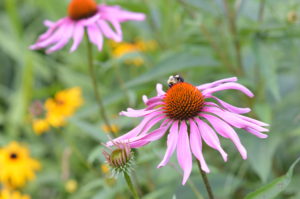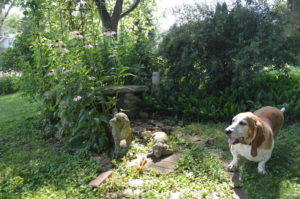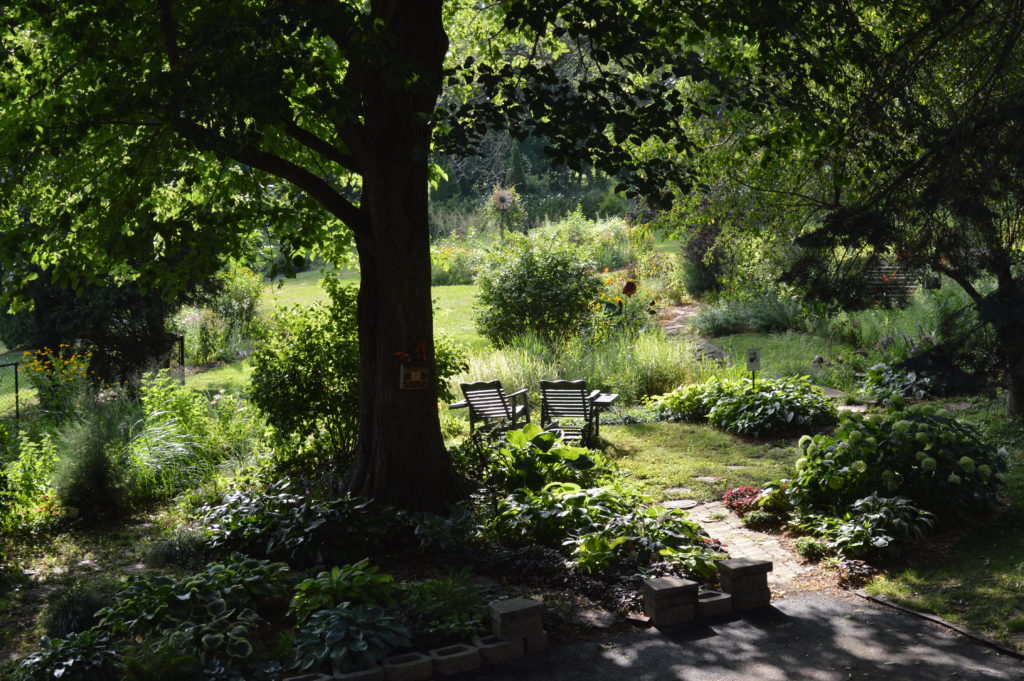
A pollinator bed is the focal point of Becki Lynch’s backyard in Cedar Rapids, Iowa, where she is shown next to a tall milkweed – the sole food source for monarch caterpillars – and natives such as purple coneflower and black-eyed Susan. The native grass Big Bluestem grows tall in the back. All of the plants are beneficial for bees, butterflies and other pollinators. (photo/Cindy Hadish)
By Cindy Hadish/for Iowa Gardener
Becki Lynch’s approach to gardening has changed over time, ultimately benefiting bees, butterflies and birds.

A bee finds a purple coneflower (Echinacea angustifolia) to its liking. The cultivar has deeper purple blossoms and narrower leaves than Echinacea purpurea. (photo/Cindy Hadish)
“It started as a very formal garden,” Becki said of the early years at her Cedar Rapids home, where she and her husband have lived since 1987. With about 3 acres of land, half of which is wooded, Becki gradually adopted a more relaxed philosophy; one that is more in-tune with nature.
In 2012, she received an Environmental Stewardship Award through Espoma and the National Gardening Association, which recognizes the efforts of gardeners working to protect and improve the environment.
“Everything from that point on has been conservation-oriented,” she said, “and work-oriented, too, cutting down on the need for hands-on work in the garden.”
Leaves from a towering white oak form a layer of mulch in a bed near the curving driveway; pachysandra, lily of the valley and other groundcovers lessen the need for weeding and formal beds have given way to native plants that serve triple duty for their beauty, ease of care and benefits to pollinators.

The family’s Basset hound, Olivia, appears at home near dog garden statues and a rustic stone bench. (photo/Cindy Hadish)
Pollinators, such as bees and butterflies, have been increasingly at-risk due to pesticide use, loss of habitat and other factors, but Becki has been at the forefront of local efforts to increase their numbers.
Native plants, including purple coneflower black-eyed Susan and milkweed – the sole food source for monarch caterpillars – are integrated throughout her property.
Milkweed, especially, has gained prominence in recent years as part of the Monarch Research Project, which Becki helped launch in the Cedar Rapids area. A Linn County Master Gardener, she continues to advise landowners and government entities seeking to make roadsides and other spaces more monarch-friendly.
“Everything has a purpose here,” Becki said of her gardens. “I truly believe everyone can have part of their property as a pollinator habitat.”
See more of this story and photos in the May/June 2018 edition of the Iowa Gardener magazine. Find extensive information on gardening in Iowa by subscribing to the Iowa Gardener.
Learn about other great Iowa gardens:
Wanda Lunn grows new and old in harmony
Daylily gardens in Central City


No Comments Yet